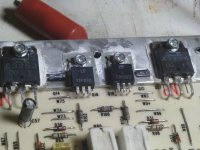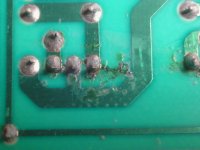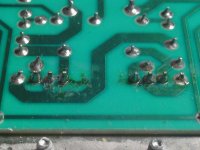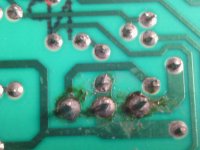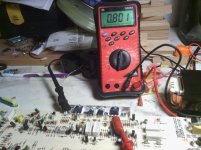Fine and thanks.
Not trying to be harsh, quite the contrary . it's just that I have often seen very well intentioned helpers offer *good* advice, no doubt about that, but the "helped " guy was offered several diverging paths to follow and got more confused than before.
. it's just that I have often seen very well intentioned helpers offer *good* advice, no doubt about that, but the "helped " guy was offered several diverging paths to follow and got more confused than before.
Really, rereading all posts, we are all basically saying about the same, just not at the same time, that's why I suggested you did things in a certain order.
Today, after all you've measured and posted here, we already have a few culprits, most agree on that, so let's replace them, test *carefully* (no speaker, using current limiter), and then we'll see, along the road.
Yes, there may be other bad things, I'd say 50% probability of that, pure seat of the pants estimation, I'm *hoping* your amp starts working just replacing that.
As I said, 50% , which is not bad.
If not , we'll continue.
, we'll continue.
Here's a post on that FM212 I commented earlier on, by a well respected Engineer who was also helping, when he saw the OP was going in 10 directions at the same time.
I think it's valid here too:
OK, cheer up, we are helping you and trust you'll succeed.
Not trying to be harsh, quite the contrary
Really, rereading all posts, we are all basically saying about the same, just not at the same time, that's why I suggested you did things in a certain order.
Today, after all you've measured and posted here, we already have a few culprits, most agree on that, so let's replace them, test *carefully* (no speaker, using current limiter), and then we'll see, along the road.
Yes, there may be other bad things, I'd say 50% probability of that, pure seat of the pants estimation, I'm *hoping* your amp starts working just replacing that.
As I said, 50% , which is not bad.
If not
Here's a post on that FM212 I commented earlier on, by a well respected Engineer who was also helping, when he saw the OP was going in 10 directions at the same time.
I think it's valid here too:
Solid state troubleshooting is a specialised skill. If you run a repair shop and don't have that skill, is it fair to take solid-state amps for repair and expect us to fix them for you?
99% of solid state amp failures go like this: an output transistor blows and takes a random selection of other components out with it. If you don't replace all of the blown components, the next time you turn it on, it blows the outputs again plus another random selection of components. If you don't replace all of those, it does the same again... And again... Troubleshooting that over the Internet is like doing brain surgery with a pointy stick. If you don't understand the circuit, a valid approach is just to replace every component. And like Markus says, don't wreck the PCB.
OK, cheer up, we are helping you and trust you'll succeed.
JMFahey
I'm not finding Digikey to have any of these transistors. Everything is showing 0 in stock. I even chatted with a tech rep' earlier.
I am looking at the data sheet for the 2sa1294 it reads at the top (complements to type 2sc3263) Can I assume that means the 3263 will interchange with the 1294? That's what I think it says but its written a bit strange, for English that is.
I'm not finding Digikey to have any of these transistors. Everything is showing 0 in stock. I even chatted with a tech rep' earlier.
I am looking at the data sheet for the 2sa1294 it reads at the top (complements to type 2sc3263) Can I assume that means the 3263 will interchange with the 1294? That's what I think it says but its written a bit strange, for English that is.
DigiKey has 3 of them, only missing 2sc3298.
Keep googling fot parts suppliers.
Avoid NTE and EBay, search "serious" suppliers as Digikey, Mouser, etc.
Attachments
I am comparing the data sheets for the 3263 and 1294 chips, both of which indicate the other is a complementary chip. The only real differences between these are small variations in how they dissipate heat and the rise and drop off of current etc. So that means these chips can be interchanged but there can or will be a change in tone etc, correct?
Attachments
Last edited:
Newark is "Farnell USA" , an excellent supplier if they are anything like the UK one.
2SC3263 - ALLEGRO SANKEN - TRANSISTOR, BJT, NPN, 230V,15A | Newark
2SA1294 - ALLEGRO SANKEN - TRANSISTOR, BJT, PNP, -230V, | Newark
For this one they suggest an NTE replacement.
Not my first choice, but it's not that ridiculously expensive and original specs are not that hard to match.
FWIW, being in Argentina I'd just slam a TIP32C there and call it a day.
But you try to use the original, if possible:
NTE2577 - NTE ELECTRONICS - TRANSISTOR, PNP, 180V, 2A, TO | Newark
For this one, they also stock an NTE.
Same considerations as before, *I* would stick a TIP31C there, but you try to find the original or the closest one.
Never bought from MCM, what do the experienced US guys think?
**Looks** serious.
160V 1.5A 20W Bce Transistor 2-10L1A | 2SC3298 | Distributed By MCM
NO 2SA1306 at MCM
Well, here you have a few, keep searching for "transistor number"+"stock"+"price" .
*Maybe* you can order from Fender, write them.
Even if "slightly more expensive", it's the real deal.
EDIT: *worst case* that you can find nothing , what I would use in Argentina would be MJL21193/21194 as outputs and TIP31C/32C as drivers.
No need to match and even less exceed original specs, both the Fender originals and those I mentioned are overkill in a puny +/-42V 100W 4 ohms guitar amp.
I churn out tons of them with humble TIP142/147 outputs, go figure. And with no problems.
But I repeat, if you can repair it "original", so much the better
2SC3263 - ALLEGRO SANKEN - TRANSISTOR, BJT, NPN, 230V,15A | Newark
2SA1294 - ALLEGRO SANKEN - TRANSISTOR, BJT, PNP, -230V, | Newark
For this one they suggest an NTE replacement.
Not my first choice, but it's not that ridiculously expensive and original specs are not that hard to match.
FWIW, being in Argentina I'd just slam a TIP32C there and call it a day.
But you try to use the original, if possible:
NTE2577 - NTE ELECTRONICS - TRANSISTOR, PNP, 180V, 2A, TO | Newark
For this one, they also stock an NTE.
Same considerations as before, *I* would stick a TIP31C there, but you try to find the original or the closest one.
Never bought from MCM, what do the experienced US guys think?
**Looks** serious.
160V 1.5A 20W Bce Transistor 2-10L1A | 2SC3298 | Distributed By MCM
NO 2SA1306 at MCM
Well, here you have a few, keep searching for "transistor number"+"stock"+"price" .
*Maybe* you can order from Fender, write them.
Even if "slightly more expensive", it's the real deal.
EDIT: *worst case* that you can find nothing , what I would use in Argentina would be MJL21193/21194 as outputs and TIP31C/32C as drivers.
No need to match and even less exceed original specs, both the Fender originals and those I mentioned are overkill in a puny +/-42V 100W 4 ohms guitar amp.
I churn out tons of them with humble TIP142/147 outputs, go figure. And with no problems.
But I repeat, if you can repair it "original", so much the better
Last edited:
Ok I finally get it. When the data sheet shows a complementary chip it doesn't mean it interchanges. It means they work together. As in NPN working with a PNP.
And my "Puny" amp does not require a chip that will handle 230v and 15 amps because it will (theoretically) never see such voltage or load in my amp. So, a chip that handles 160v is more than enough to handle my 42v power rails.
And my "Puny" amp does not require a chip that will handle 230v and 15 amps because it will (theoretically) never see such voltage or load in my amp. So, a chip that handles 160v is more than enough to handle my 42v power rails.
Perfect, now you have a better idea as to how it works, cool. 

 )
)
Your power and driver transistors need to handle end to end rail voltage , or 84V
Some margin is advisable, so 90 or 100V devices are fine.
The originals and the suggested replacements handle between 160 and 250V , so .....
A little "trade secret" here: many respected Techs (such as Enzo), who handle many different brands, both famous and obscure, tend to stock, say, 50+50 MJ15024/15025 transistors, the top of the pyramid, and use them *everywhere* they need a metallic TO3, even when the original one was a humble 2N3055 .
Are they "wasting" money?
Not at all, an amp *may* be repaired the same day it's opened, instead of wasting up to a week between placing an order and receiving it ... plus you will probably pay much less postage per unit than ordering singly.
In your amp the original Japanese transistors are *very* good, but the "last chance" Americans I mentioned are also quite good (not so "Hi Fi" .... but in a guitar amp that's not a disadvantage).
As of current, 40V into 4 ohms is peak 10A.
Since supply voltage drops somewhat with load (it is not regulated), transistors themselves also add loss, you also have emotter resistors in series with the load, probably 8A peak are enough.
So transistors which handle 14 to 16A continuously are also more than enough.
That amp in fact is not puny, it can hold very well in a Club situation and such, I used the word comparing it to the monsters which can be built with those transistors.
Good luck.
Yes, it's exactly that.Ok I finally get it. When the data sheet shows a complementary chip it doesn't mean it interchanges. It means they work together. As in NPN working with a PNP.
Correct again ( ..... and counting ....And my "Puny" amp does not require a chip that will handle 230v and 15 amps because it will (theoretically) never see such voltage or load in my amp. So, a chip that handles 160v is more than enough to handle my 42v power rails.
Your power and driver transistors need to handle end to end rail voltage , or 84V
Some margin is advisable, so 90 or 100V devices are fine.
The originals and the suggested replacements handle between 160 and 250V , so .....
A little "trade secret" here: many respected Techs (such as Enzo), who handle many different brands, both famous and obscure, tend to stock, say, 50+50 MJ15024/15025 transistors, the top of the pyramid, and use them *everywhere* they need a metallic TO3, even when the original one was a humble 2N3055 .
Are they "wasting" money?
Not at all, an amp *may* be repaired the same day it's opened, instead of wasting up to a week between placing an order and receiving it ... plus you will probably pay much less postage per unit than ordering singly.
In your amp the original Japanese transistors are *very* good, but the "last chance" Americans I mentioned are also quite good (not so "Hi Fi" .... but in a guitar amp that's not a disadvantage).
As of current, 40V into 4 ohms is peak 10A.
Since supply voltage drops somewhat with load (it is not regulated), transistors themselves also add loss, you also have emotter resistors in series with the load, probably 8A peak are enough.
So transistors which handle 14 to 16A continuously are also more than enough.
That amp in fact is not puny, it can hold very well in a Club situation and such, I used the word comparing it to the monsters which can be built with those transistors.
Good luck.
A little "trade secret" here: many respected Techs (such as Enzo), who handle many different brands, both famous and obscure, tend to stock, say, 50+50 MJ15024/15025 transistors, the top of the pyramid, and use them *everywhere* they need a metallic TO3, even when the original one was a humble 2N3055 .
Very true - I tend to only stock the higher rated parts (as for example I only stock 105 degree high quality electrolytics, and where transistors are available in various voltage ratings I only stock the highest one - such as TIP41C).
However, it's not about increased reliability (although that's probably a happy by-product), it's simply about minimising stock levels and keeping them manageable. I'm currently in the process of moving the service department at work - to a room about 25% of it's existing size
Yes, there is absolutely zero reason to stock for example 1N4001, 1N4004, and 1N4007, when the 1N4007 works in place of all of them. One drawer instead of three.
If they spec a 250v part when a 160v part would work as well, don;t sweat it. it isn't like the higher voltage part will add any stress. There are a lot of reasons for such choices, not the least of which is the manufacturer can also save duplications in inventory just like my diode example.
If they spec a 250v part when a 160v part would work as well, don;t sweat it. it isn't like the higher voltage part will add any stress. There are a lot of reasons for such choices, not the least of which is the manufacturer can also save duplications in inventory just like my diode example.
Line No:
1 Stock No:
03C3669 Manufacturer Part No:
2SA1294 UOM
Each 1 Quantity Shipped:
2 Price:
$2.78 Extended Price:
$5.56 Customer Part Number: Description: TRANSISTOR, BJT, PNP, -230V, -15A, MT-100 (TO3P); Transistor Polarity:NPN; Collector Emitter Voltage V(br)ceo:-230V; Transition Frequency Typ ft:35MHz; Power Dissipation Pd:130W; DC Collector Current:-15A; DC Current Gain hFE:50
Line No:
2 Stock No:
03C3691 Manufacturer Part No:
2SC3263 UOM
Each 1 Quantity Shipped:
2 Price:
$3.63 Extended Price:
$7.26 Customer Part Number: Description: TRANSISTOR, BJT, NPN, 230V,15A,TO-3P; Transistor Polarity:NPN; Collector Emitter Voltage V(br)ceo:230V; Transition Frequency Typ ft:60MHz; Power Dissipation Pd:130W; DC Collector Current:15A; DC Current Gain hFE:50; No. of Pins:3
Line No:
4 Stock No:
50P9593 Manufacturer Part No:
MK3306 UOM
Pack 10 Quantity Shipped:
1 Price:
$2.52 Extended Price:
$2.52 Customer Part Number: Description: INSULATING KIT; Insulator Body Material:Mica; Breakdown Voltage Vbr:1kV; Thickness:0.1mm; Body Material:Mica; Length:19mm; Mounting Hole Dia:3.6mm; Overall Width:15mm; Package / Case:TO-220
Line No:
5 Stock No:
24M0269 Manufacturer Part No:
53-77-2G UOM
Each 1 Quantity Shipped:
5 Price:
$0.456 Extended Price:
$2.28 Customer Part Number: Description: INSULATOR; Insulator Body Material:Silicone Rubber; Thickness:0.152mm; Volume Resistivity:1015ohm-cm; Dielectric Strength:667kV/mm; Body Material:Silicone Rubber; Length:17.5mm; Mounting Hole Dia:3.18mm; Overall Width:14.27mm
Line No:
6 Stock No:
81F046 Manufacturer Part No:
273-AB UOM
Each 1 Quantity Shipped:
4 Price:
$0.466 Extended Price:
$1.86 Customer Part Number: Description: HEAT SINK; Packages Cooled:TO-218 / TO-220; Thermal Resistance:49øC @ 2W; External Height - Imperial:0.374"; External Height - Metric:9.5mm; External Width - Imperial:0.752"; External Width - Metric:19.1mm
Line No:
7 Stock No:
35C0641 Manufacturer Part No:
TIP31C UOM
Each 1 Quantity Shipped:
3 Price:
$0.611 Extended Price:
$1.83 Customer Part Number: Description: RF TRANSISTOR, NPN 100V 3MHZ TO-220; Transistor Polarity:NPN; Collector Emitter Voltage V(br)ceo:100V; Transition Frequency Typ ft:3MHz; Power Dissipation Pd:40W; DC Collector Current:3A; DC Current Gain hFE:50
Line No:
8 Stock No:
35C0642 Manufacturer Part No:
TIP32C UOM
Each 1 Quantity Shipped:
3 Price:
$0.611 Extended Price:
$1.83 Customer Part Number: Description: BIPOLAR TRANSISTOR, PNP, -100V, TO-220; Transistor Polarity NP; Collector Emitter Voltage V(br)ceo:-100V; Transition Frequency Typ ft:3MHz; Power Dissipation Pd:40W; DC Collector Current:3A; DC Current Gain hFE:50
NP; Collector Emitter Voltage V(br)ceo:-100V; Transition Frequency Typ ft:3MHz; Power Dissipation Pd:40W; DC Collector Current:3A; DC Current Gain hFE:50
1 Stock No:
03C3669 Manufacturer Part No:
2SA1294 UOM
Each 1 Quantity Shipped:
2 Price:
$2.78 Extended Price:
$5.56 Customer Part Number: Description: TRANSISTOR, BJT, PNP, -230V, -15A, MT-100 (TO3P); Transistor Polarity:NPN; Collector Emitter Voltage V(br)ceo:-230V; Transition Frequency Typ ft:35MHz; Power Dissipation Pd:130W; DC Collector Current:-15A; DC Current Gain hFE:50
Line No:
2 Stock No:
03C3691 Manufacturer Part No:
2SC3263 UOM
Each 1 Quantity Shipped:
2 Price:
$3.63 Extended Price:
$7.26 Customer Part Number: Description: TRANSISTOR, BJT, NPN, 230V,15A,TO-3P; Transistor Polarity:NPN; Collector Emitter Voltage V(br)ceo:230V; Transition Frequency Typ ft:60MHz; Power Dissipation Pd:130W; DC Collector Current:15A; DC Current Gain hFE:50; No. of Pins:3
Line No:
4 Stock No:
50P9593 Manufacturer Part No:
MK3306 UOM
Pack 10 Quantity Shipped:
1 Price:
$2.52 Extended Price:
$2.52 Customer Part Number: Description: INSULATING KIT; Insulator Body Material:Mica; Breakdown Voltage Vbr:1kV; Thickness:0.1mm; Body Material:Mica; Length:19mm; Mounting Hole Dia:3.6mm; Overall Width:15mm; Package / Case:TO-220
Line No:
5 Stock No:
24M0269 Manufacturer Part No:
53-77-2G UOM
Each 1 Quantity Shipped:
5 Price:
$0.456 Extended Price:
$2.28 Customer Part Number: Description: INSULATOR; Insulator Body Material:Silicone Rubber; Thickness:0.152mm; Volume Resistivity:1015ohm-cm; Dielectric Strength:667kV/mm; Body Material:Silicone Rubber; Length:17.5mm; Mounting Hole Dia:3.18mm; Overall Width:14.27mm
Line No:
6 Stock No:
81F046 Manufacturer Part No:
273-AB UOM
Each 1 Quantity Shipped:
4 Price:
$0.466 Extended Price:
$1.86 Customer Part Number: Description: HEAT SINK; Packages Cooled:TO-218 / TO-220; Thermal Resistance:49øC @ 2W; External Height - Imperial:0.374"; External Height - Metric:9.5mm; External Width - Imperial:0.752"; External Width - Metric:19.1mm
Line No:
7 Stock No:
35C0641 Manufacturer Part No:
TIP31C UOM
Each 1 Quantity Shipped:
3 Price:
$0.611 Extended Price:
$1.83 Customer Part Number: Description: RF TRANSISTOR, NPN 100V 3MHZ TO-220; Transistor Polarity:NPN; Collector Emitter Voltage V(br)ceo:100V; Transition Frequency Typ ft:3MHz; Power Dissipation Pd:40W; DC Collector Current:3A; DC Current Gain hFE:50
Line No:
8 Stock No:
35C0642 Manufacturer Part No:
TIP32C UOM
Each 1 Quantity Shipped:
3 Price:
$0.611 Extended Price:
$1.83 Customer Part Number: Description: BIPOLAR TRANSISTOR, PNP, -100V, TO-220; Transistor Polarity
Cool.
A little over-detailed but I seem to understand you ordered 2 of 2SA1294, 2 of 2SC3263, and 3 each of TIP31C and TIP32C. Fine.
but I seem to understand you ordered 2 of 2SA1294, 2 of 2SC3263, and 3 each of TIP31C and TIP32C. Fine.
Spares are always good, and really, parts price is not expensive, worst is postage and delay. Oh well.
Also TO220 micas and TO218/247 SilPads. Fine.
Did't understand what is referred to as "heatsink" , anyway you will use the original ones, and you will still need some thermal grease for the TO220 transistors (Silpads don't need it).
If you forgot, don't worry, local Radio Shack will have some small preloaded syringe or small pot available.
You can carefully replace dead and suspect transistors, you have spares in case of Murphy's Law , which is good, and after rechecking everything with good light and glasses against errant solder drops and the like, you can turn the amp on, no speaker, through the bulb limiter.
There's a reasonably high probability that your amp will work, and if not, knowing semiconductors are fresh and good, it's easier to find any other part still bad, if any.
Congratulations.
A little over-detailed
Spares are always good, and really, parts price is not expensive, worst is postage and delay. Oh well.
Also TO220 micas and TO218/247 SilPads. Fine.
Did't understand what is referred to as "heatsink" , anyway you will use the original ones, and you will still need some thermal grease for the TO220 transistors (Silpads don't need it).
If you forgot, don't worry, local Radio Shack will have some small preloaded syringe or small pot available.
You can carefully replace dead and suspect transistors, you have spares in case of Murphy's Law , which is good, and after rechecking everything with good light and glasses against errant solder drops and the like, you can turn the amp on, no speaker, through the bulb limiter.
There's a reasonably high probability that your amp will work, and if not, knowing semiconductors are fresh and good, it's easier to find any other part still bad, if any.
Congratulations.
Last edited:
Cool, way to go.I'm excited!
Now, I don't know what you ordered those heatsinks for, the FM212 already has its own (much larger , by the way).
You must re-mount everything as it was originally.
But I'm happy too, we are in the good path.
My new parts arrived today. I carefully removed the transistors and installed the new one and connected the wires and flipped the switch with no speaker and the light on the current limiter came on. So that was a disappointment. Now I am going over everything again trying to fine what I could have possibly done wrong with this thing. Not sure what to check now.
I would next check the rest of the transistors in the driver stages for shorts.
You could also check the resistors are the correct values and haven't burned out.
Check any capacitors for shorts.
I have seen me resort to taking out all the transistors out and checking the gain on a meter.
I had one amp with 12 transistors and by sods law it was the last transistor that had failed with a gain of 1.
I found that after removing all the transistors it was easier to check all the passive components.
You could also check the resistors are the correct values and haven't burned out.
Check any capacitors for shorts.
I have seen me resort to taking out all the transistors out and checking the gain on a meter.
I had one amp with 12 transistors and by sods law it was the last transistor that had failed with a gain of 1.
I found that after removing all the transistors it was easier to check all the passive components.
I think yoy replaced transistors right (hope so), but maybe there are still other problems.trying to fine what I could have possibly done wrong with this thing
Start by:
1) with amp off and unplugged from mains, and multimeter set on diode test, check lack of continuity betwen each new transistor collector (centerleg) and ground.
You might have had some burr under the micas, or over pressed the silpads, it's not that hard to go through them, they are as hard as a piece of a kid's Birthday balloon.
And don't despair, sometimes you get lucky on first try (I hoped so), sometimes you must test a little more.
Good luck.
New Resistors
Transistor Collector test, meter set to Diode Test:
Q20 - .002
Q18 - .002
Q19 - .002
Q21 - see pic
Transistor Collector test, meter set to Diode Test:
Q20 - .002
Q18 - .002
Q19 - .002
Q21 - see pic
Attachments
Well, I see a nice, solid *short* there.
Two of them in fact.
*My* fault, of course.
I should have warned you that the original Japanese transistor has a built-in plastic insulated tab and the hole in it, while the TIP has an exposed metal tab and mounting hole.
That's why the Japanese has a 3 mm hole, and the American has a larger 4 mm one, so you can fit an insulated nipple there, which both insulates the hole inside and the screw head:
You need this, which you won't have to order, I'm sure local Radio Shack or equivalent has it:

You needn't solder anything, just pull the screw, push the nipple in the hole and replace screw.
Sorry
Two of them in fact.
*My* fault, of course.
I should have warned you that the original Japanese transistor has a built-in plastic insulated tab and the hole in it, while the TIP has an exposed metal tab and mounting hole.
That's why the Japanese has a 3 mm hole, and the American has a larger 4 mm one, so you can fit an insulated nipple there, which both insulates the hole inside and the screw head:
You need this, which you won't have to order, I'm sure local Radio Shack or equivalent has it:

You needn't solder anything, just pull the screw, push the nipple in the hole and replace screw.
Sorry
I installed the insulators as instructed and hooked the power and the current limiter lit but just barely. So I hooked directly to power and flipped the switch and the fuse did not blow. S I then hooked up the speakers and my guitar and there is no sound coming out. I adjusted all the knobs and got nothing. I tried the drive and more drive channels and still nothing.
At idle there is a very slight hum or buzz. Its almost inaudible. I have to really listen to hear it.
The Q 18, 19, 20 and 21 are pretty hot. I imagine they run hot since they need such a large heat sink but these are pretty hot. I'm talking burn my finger hot. Is that normal?
I don't want to turn this back on till here back from you but when I do fire it up I have a laser thermometer I can get the surface temp if you need it.
Thanks!
BR
At idle there is a very slight hum or buzz. Its almost inaudible. I have to really listen to hear it.
The Q 18, 19, 20 and 21 are pretty hot. I imagine they run hot since they need such a large heat sink but these are pretty hot. I'm talking burn my finger hot. Is that normal?
I don't want to turn this back on till here back from you but when I do fire it up I have a laser thermometer I can get the surface temp if you need it.
Thanks!
BR
- Home
- Live Sound
- Instruments and Amps
- Fender FM212R Problems

